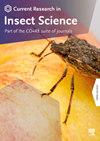The multifaceted role of brood communication in wasp societies
IF 2.7
Q1 ENTOMOLOGY
引用次数: 0
Abstract
The family Vespidae represents a key group to understand the evolutionary trajectory of social behavior in insects, as these wasps display the entire spectrum of social behaviors, from solitary to highly eusocial. The evolution of eusociality likely depended on a coordinated communication system, with chemical communication being suggested as the most commonly used among social insects. Chemical communication provides information about colony identity and an individual's identity, sex and caste, and can help resolve intracolonial conflicts. Parallel to the communication observed in adult-to-adult interactions, several reports have highlighted that the brood (eggs, larvae or pupae) can also act as direct or indirect sources of chemical compounds that can convey information. For example, eggs are covered with chemical substances that provide information about egg maternity and the queen's fertility. Given the increase in the past years of studies aiming to understand how brood can contribute to social dynamics, we reviewed the literature about the information conveyed by brood in wasp's nests across different levels of sociality. The main goal of this review was to synthesize the current knowledge and provide new venues of research. We addressed five main subjects (1) brood mediated conflicts and underlying mechanisms, (2) brood parasitism, (3) hydrocarbon cues covering brood, (4) juvenile hormone influencing brood scent and (5) other modes of communication used by brood.

黄蜂社会中幼蜂交流的多方面作用
黄蜂科代表了理解昆虫社会行为进化轨迹的关键群体,因为这些黄蜂表现出从独居到高度群居的整个社会行为谱。群居性的进化可能依赖于协调的通信系统,化学通信被认为是群居昆虫中最常用的。化学通信提供了关于群体和个体身份、性别和种姓的信息,并有助于解决殖民地内部的冲突。与在成虫与成虫的互动中观察到的交流平行,一些报告强调,幼虫(卵、幼虫或蛹)也可以作为可以传递信息的化合物的直接或间接来源。例如,卵上覆盖着一层化学物质,可以提供有关卵的母性和蚁后的生育能力的信息。鉴于过去几年来研究蜂群如何对社会动态做出贡献的研究增加,我们回顾了关于不同社会水平的蜂巢中蜂群传递信息的文献。这篇综述的主要目的是综合现有的知识和提供新的研究场所。我们研究了五个主要主题:(1)幼虫介导的冲突及其潜在机制;(2)幼虫寄生;(3)覆盖幼虫的碳氢化合物线索;(4)幼体激素影响幼虫气味;(5)幼虫使用的其他交流模式。
本文章由计算机程序翻译,如有差异,请以英文原文为准。
求助全文
约1分钟内获得全文
求助全文
来源期刊

Current Research in Insect Science
Agricultural and Biological Sciences-Animal Science and Zoology
CiteScore
3.20
自引率
0.00%
发文量
22
审稿时长
36 days
 求助内容:
求助内容: 应助结果提醒方式:
应助结果提醒方式:


